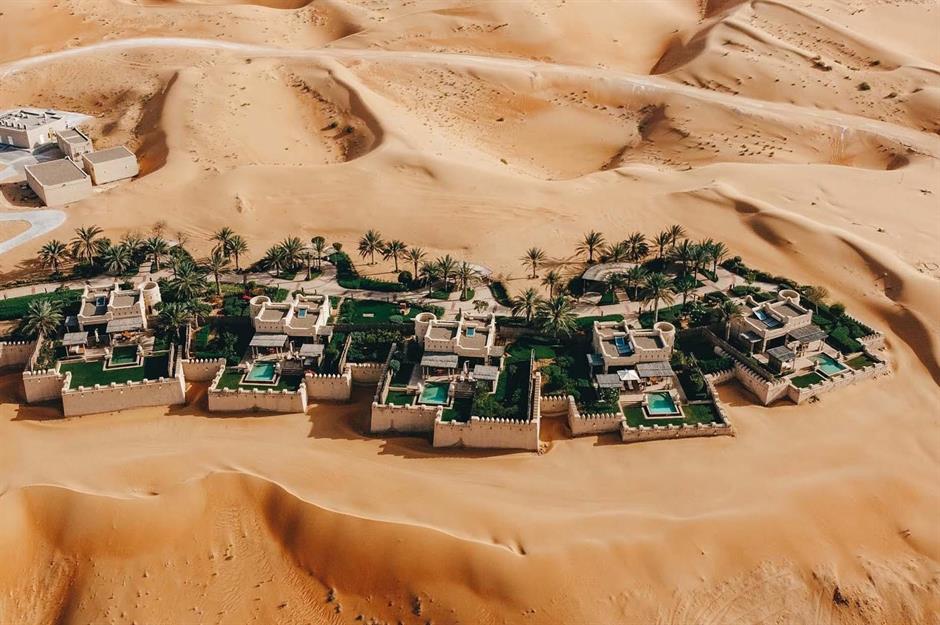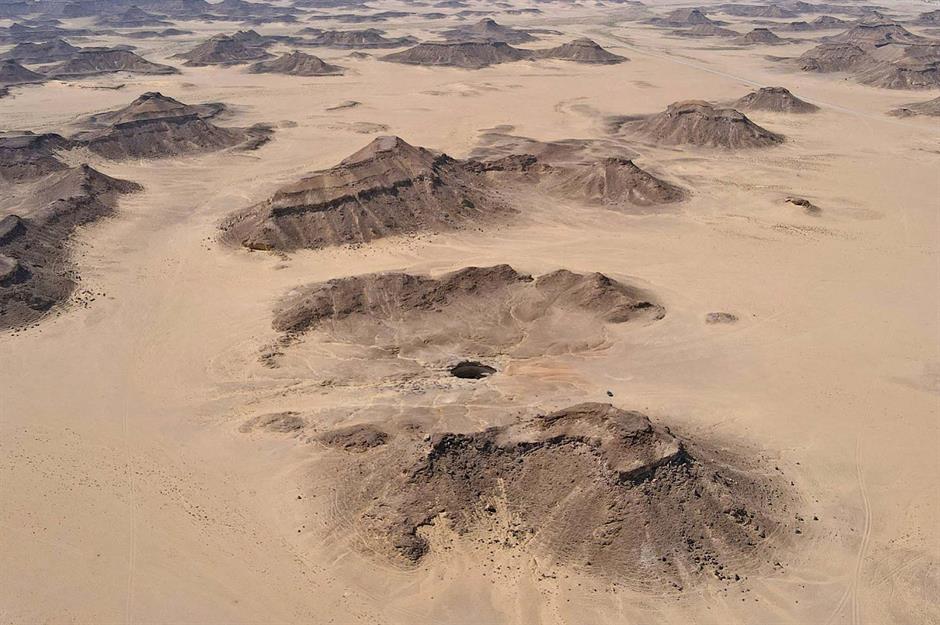Secret wonders hidden in the world’s largest deserts
Surprising spots
Well of Barhout, Yemen
This sinkhole in Yemen's remote eastern desert landscape looms large in the local people's imagination. Nicknamed Hell Pit and Well of Hell, it's central to many legends, including one that claims it's a prison for demons. The well is around 100-feet (30m) wide and is thought to be as much as 820-feet (250m) deep. No one has ever been to the bottom of the sinkhole, but a local geological crew reached a depth of around 170 feet (52m) and reported foul smells, lack of oxygen and no ventilation.
Fairy Circles, Namibia
Masada, Israel
Masada, Israel
Wadi Shab, Oman
Mysk Al Faya Retreat, UAE
A 5-star luxury hotel and spa is the last thing you’d expect to find in the middle of the Sharjah desert but that's exactly where Mysk Al Faya Retreat is located. Formerly a clinic and grocery store, the two stone buildings that make up the hotel were originally built over half a century ago. Just 22 miles (35km) from Dubai airport, it's nearly equidistant from the Persian Gulf and the Gulf of Oman.
Mysk Al Faya Retreat, UAE
This five-room boutique hotel really does offer an escape from it all. Over the road a new building houses a salt-water spa complete with an open-air swimming pool. Each bedroom has its own star-gazing skylight and there’s also a fire pit primed for recapping the day's many adventures.
Love this? Follow our Facebook page for more travel inspiration
Petra, Jordan
Petra, Jordan
There's always more being discovered at the site. Modern technology has helped researchers uncover a giant platform, a similar size to an Olympic swimming pool. After poring over satellite and drone images, archaeologists noticed a large rectangular structure not far from the famous Treasury (pictured). It’s thought that the structure was once lined with columns, and experts muse that it could have been a holy building, or some sort of public administrative building.
Discover incredible new secrets of the world's ancient wonders
Saint Catherine's Monastery, Mount Sinai, Egypt
Saint Catherine's Monastery, Mount Sinai, Egypt
Gas Haven, near Ouarzazate, Morocco
It's not just historic ruins you'll find in the world's deserts. Anyone who’s seen the 2006 horror movie The Hills Have Eyes might recognise the stretch of desert outside the city of Ouarzazate in Morocco, which doubled for the US West Coast. In the film, Gas Haven petrol station is where the family first hear of a shortcut through the desert from the store’s creepy clerk.
Atlas Corporation Studios, near Ouarzazate, Morocco
Gas Haven isn't the only movie location in the area either. It was actually the producers of Lawrence of Arabia (1962) who first saw the potential in the desert outside of Ouarzazate. They needed a location to stand in for Western Asia, with consistent weather and a remote position near the Sahara and Morocco's wilderness fitted the bill. But it wasn't until 1983 that these studios officially opened, providing sets for re-enactments of biblical locations, ancient civilisations and brilliant works of fiction alike.
Longitude 131°, Northern Territory, Australia
Views don’t get much better than the one at Longitude 131°. The luxury desert basecamp sits in the shadow of Uluru (Ayers Rock), the massive sandstone monolith at the heart of Australia’s Northern Territories and World Heritage-listed wilderness.
Longitude 131°, Northern Territory, Australia
Tataouine, Tunisia
Tataouine, Tunisia
The city features in George Lucas’ intergalactic saga Star Wars, most predominantly in the first of the prequels, 1999’s Star Wars: Episode I – The Phantom Menace. It stands in for Tatooine, the home planet of Anakin Skywalker, who grows up to become super villain Darth Vader.
Scotty’s Castle, California, USA
Scotty’s Castle, California, USA
In 1970, Death Valley National Park purchased Scotty’s Castle which was being used as a guesthouse. Around 100,000 people typically visit the Mission and Spanish Colonial Revival-style villa each year due to its convenient location around a three-hour drive from Las Vegas. However, the villa was damaged by severe flooding in 2015 and has not been open to the public since. There's suggestion this mesmerising desert attraction could open next year.
Coober Pedy, South Australia, Australia
Coober Pedy, South Australia, Australia
Since 1988, the Desert Cave Hotel has welcomed visitors to this unusual attraction, offering guests the opportunity to experience a night deep underground. Opal mining machinery was used to cut away the sandstone, creating quiet, cool, dark and airy chambers in which the hotel was brought to life. The Desert Cave Hotel also has underground shops, a café, a bar and gaming room.
Kolmanskop, Namibia
Kolmanskop, Namibia
Kolmanskop was ultimately abandoned in 1956 and in fewer than 50 years the town had lived, flourished and died. At the peak of its popularity the town bloomed with lush gardens, manicured lawns, rose beds and eucalyptus trees, and boasted a ballroom, theatre, sports hall, casino and ice factory. Over the past six decades, the town has been reclaimed by the Namib desert and many of the homes are disappearing into the sand dunes.
Amangiri, Utah, USA
The Amangiri resort is a great example of a hotel which takes careful measures not to disturb its surroundings. Surrounded by some of North America’s most beautiful rock formations which have remained untouched for millions of years, Amangiri sits at the heart of the Grand Circle within easy reach of the Grand Canyon, Bryce Canyon, Zion National Park and Monument Valley.
Amangiri, Utah, USA
Desert Breath, Egypt
Greek art collective D.A.ST. Arteam created this eye-catching installation in 1997 near the resort town of El Gouna in the Sahara Desert. The 280,000-square-foot (26,012sq m), spiral-shaped sand sculpture radiates out from a vessel, 100 feet (30m) in diameter, that was once filled with water, which has since evaporated. The piece consists of 89 protruding cones that gradually increase in size. The artwork is slowly being reclaimed by nature and the artists have said they created this unusual installation to serve as an instrument to measure the passage of time.
Nazca Lines, Peru
Around 300 figures, from a spider to a hummingbird, are etched into the sands in the southern Peruvian desert, with some lines stretching more than five miles (3.2km). The pre-Columbian geoglyphs, which cover around 200 miles (322km), long had celestial associations or were seen as a giant calendar. Now the most popular theory is that they marked the locations of rituals surrounding water and crops – although the truth remains elusive.
Richat Structure, Mauritania
Scarabeo Camp, Morocco
Scarabeo Camp, Morocco
Scarabeo Camp, located in the Agafay Desert, allows guests to stay in one of the world’s most inhospitable environments, with every home comfort they could wish for. Its unique glamping tents have African woven matting, Moroccan Berber rugs and atmospheric lanterns. It's a place to truly get away from it all by taking in the landscape on buggy or quad rides, relaxing during yoga classes or massage sessions, or observing the stars and the moon with an astronomer.
Havasu Falls, Arizona, USA
This dreamy waterfall makes its velvety cascade in a remote area a little outside the Grand Canyon National Park. The landscape is incredible, with dramatic, honey-coloured gorges, waterfalls and blue-green swimming holes, with the vivid colours of Havasu Falls the most striking of all. It’s one of five waterfalls on the Havasupai Indian Reservation, whose residents are known as “people of the blue green water”.
Havasu Falls, Arizona, USA
Any avid hikers or wild swimming enthusiasts normally need to buy a permit when the season's dates go live, plus a reservation to camp overnight in order to reach the falls. But the advance organisation and arduous climbs in the searing heat are well worth it to experience the picture-perfect lagoon which awaits inside the canyon. Note the area is currently closed to visitors.
Prada Marfa, Texas, USA
Qasr Al Sarab Desert Resort, UAE
The Qasr Al Sarab Desert Resort looks like something from a fantasy film. This sprawling beige fortress-like resort sits marooned in the middle of the Liwa desert near the Saudi Arabian border. Inside, the resort is a verdant oasis of palm trees and swimming pools, a speck of green and blue within a sea of soft sand dunes that disappear into the horizon.
Qasr Al Sarab Desert Resort, UAE
Located on the border of the Empty Quarter, the largest uninterrupted stretch of sand in the world, the resort is a great destination for dune-based activities. Think desert yoga at dawn, mountain biking, camel trekking and horse riding on your very own Arabian adventure.
Hand of the Desert, Chile
The Atacama Desert stretches around 60 miles (97km) along Chile’s Pacific Coast and is one of the driest places on Earth – the only true desert to receive less precipitation than the polar deserts. It's where Chilean artist Mario Irarrázabal decided to build his towering sculpture Mano de Desierto, or Hand of the Desert, in the early 1980s.
Now discover more of the world's most jaw-dropping sculptures here

